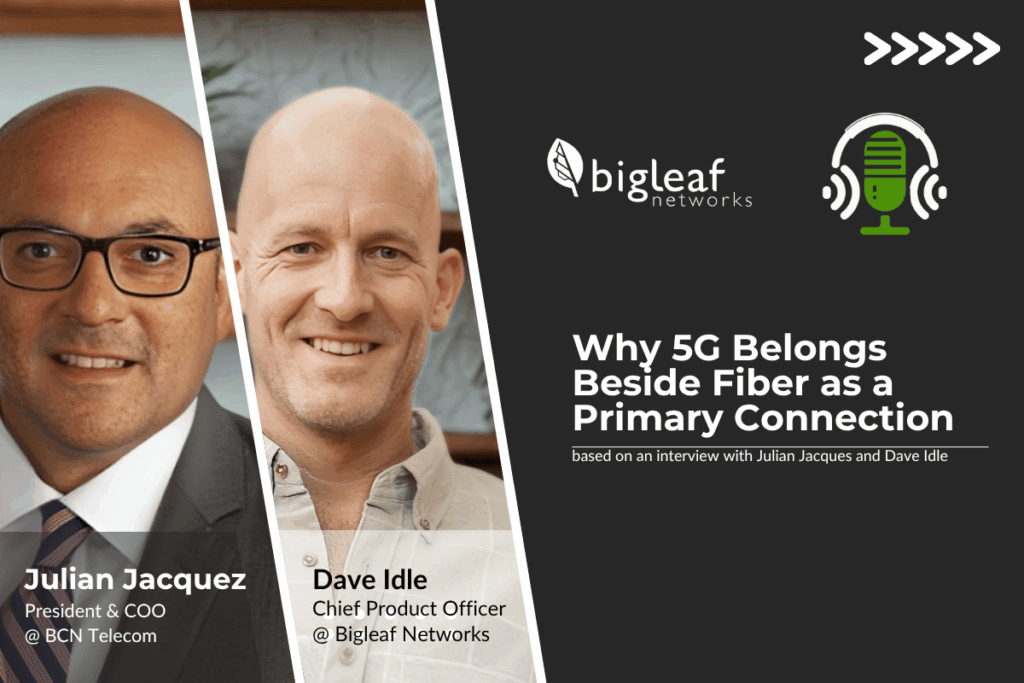5G has evolved from a backup connection to a primary option for many business environments. BCN Telecom’s Julian Jacquez and Bigleaf’s Dave Idle explain how customer expectations, deployment realities, and SD-WAN technology have pushed wireless into a central role in resilient network design—reinforced by industry insights from The State of Wireless WAN 2023.
5G stands shoulder-to-shoulder with fiber
Julian explains that customer needs drive every decision. Many sites face construction delays, limited service availability, or short-term operations that make fiber installation impractical. In these environments, 5G performs at a level that matches or exceeds wired alternatives.
“We find that it can stand right up against the wired connection and even the fiber connection.” – Julian Jacquez
This tracks with architectural guidance from Bigleaf’s wireless-first infrastructure analysis.
Activation speed and flexible deployment
Wireless accelerates deployments across temporary, remote, or mobile sites. Julian shares examples ranging from international multi-site rollouts to project-based environments where connectivity must be available immediately.
Dave notes that Bigleaf’s unified single-box solution eliminates the need for separate wireless routers. Multiple media types—fiber, cable, 4G, 5G, satellite—can be blended cleanly through SD-WAN, reducing the burden on IT teams and speeding activation. Industry research shows wireless WAN is increasingly favored for resilient activation.
Multi-path networks strengthen resilience
Demand for dual and multi-path connectivity has doubled. Businesses no longer depend on a single connection. Two or more active links are now the expectation.
Julian explains that customers often achieve better economics by adding wireless as a second or third connection. Throughput increases, SLAs improve, and the overall experience becomes more consistent—similar to findings on network resiliency and enterprise growth.
Dave adds that carriers recognize this shift. They’re now competing to deliver multiple connections per customer, including hardened wireless designs that create more dependable experiences across locations. These carrier strategies are well covered across the BCN partner ecosystem and industry commentary such as the unbreakable internet mandate.
What 5G as a Primary Path Means for IT Leaders
- 5G now rivals fiber as a primary connection — reinforced by wireless WAN adoption data
- Single-box SD-WAN simplifies wired and wireless blending
- Multi-path designs strengthen uptime and SLAs
- Wireless accelerates activation across temporary and remote sites
- Carriers are shifting to multi-connection offerings
- Cloud applications benefit from direct routing and prioritized traffic
This matches best practices from Bigleaf resources on SD-WAN performance optimization.
Where 5G Strengthens Multi-Site and Edge Deployments
- Why 5G belongs in primary network planning
- How SD-WAN unifies multiple media types — supported by hybrid SD-WAN guidance
- Why wireless-first improves deployment speed
- How multi-path networks increase customer confidence
- Why economics favor adding a second or third connection
Built for cloud-ready performance
Dave emphasizes that modern connectivity must protect cloud application performance. Bigleaf prioritizes critical traffic and maintains session integrity, even as connections fluctuate. Up to 40–50 percent improvements have been measured when Bigleaf optimizes cloud routes—patterns mirrored in BCN’s unbreakable network evolution analysis.
This is essential for locations transitioning from legacy POTS lines or copper links. Wireless becomes the primary connection by default, and SD-WAN maintains predictable performance for voice, point-of-sale, and other critical systems.
Why 5G Belongs in Your Primary Network Strategy
5G has earned its place beside fiber as a primary connection. When combined with SD-WAN and multi-path design, it delivers the speed, resilience, and flexibility modern operations require.
Related Links:
- Episode: Unbreakable Connections With Wireless-First Network Resilience
- Unbreakable Connectivity: Why Wireless Belongs Beside Fiber
- Creating a Unified Connectivity Experience Across Four Links
- Why 5G Belongs Beside Fiber as a Primary Connection
- Watch the YouTube Playlist of video episodes
- Watch the YouTube Shorts Playlist
- Subscribe to the LinkedIn Newsletter
- Listen on Captivate: Go Beyond the Connection
- Follow us on social: Linkedin | Facebook | Instagram
